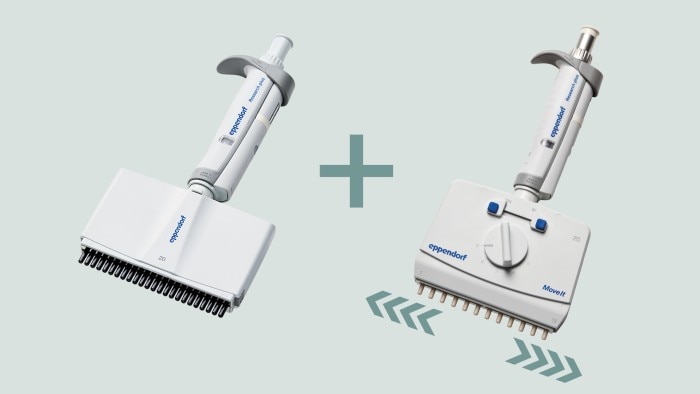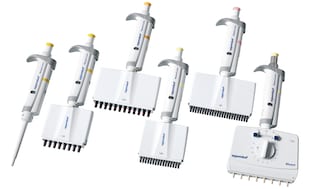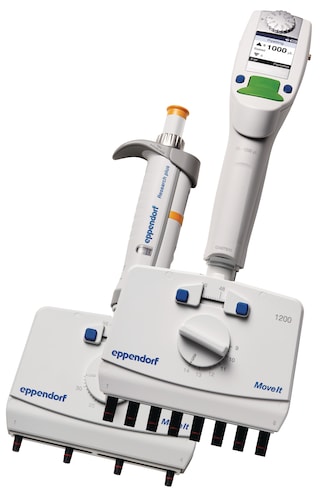MENÜ
DE | EUR
DE | EUR
-
- Tischzentrifugen
- Standzentrifugen
- Gekühlte Zentrifugen
- Mikrozentrifugen
- Mehrzweckzentrifugen
- Hochgeschwindigkeitszentrifugen
- Ultrazentrifugen
- Concentrator
- IVD Produkte
- High-Speed and Ultracentrifuge Consumables
- Zentrifugenröhrchen
- Zentrifugenplatten
- Gerätemanagement
- Proben- und Informationsmanagement
-
- Manuelles Pipettieren & Dispensieren
- Mechanische Pipetten
- Elektronische Pipetten
- Mehrkanalpipetten
- Direktverdrängerpipetten & Dispenser
- Automatisches Pipettieren
- Flaschenaufsatzdispenser
- Pipettierhilfen
- Pipettenspitzen
- Verbrauchsartikel für die Automation
- Zubehör für Dispenser & Pipetten
- Zubehör für die Automation
- Services für Dispenser & Pipetten
Es konnten keine Ergebnisse gefunden werden.
Such-Empfehlungen
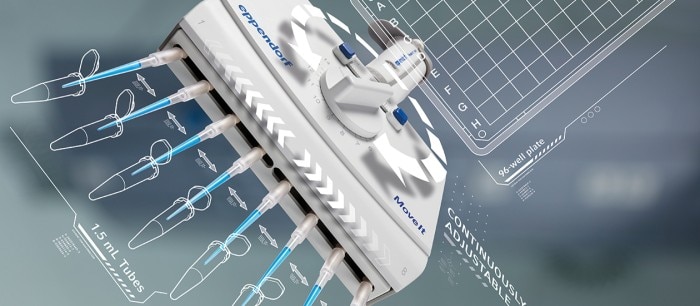
384-Well Pipetting - Time to Fire the Rocket
Dr. Stefanie Rösel Lab Academy
- Pharma
- Health & Medicine
- Pipetting & Dispensing
- Efficiency
- Accuracy
- Pipettes
- Essay
384-well microplates incredibly improve our high-throughput lab routines. But for all its advantages, researchers who are dependent on a manual system suffer twice: tiny reaction vessels in an incredible number of 384, waiting for 384 individual samples. Here we show you how you can save 70 % of your valuable time.
Pipetting the smallest volumes by hand into a 384-well format is laborious. The plate is miniaturized, the wells are tiny. Although 8- or 12-channel pipettes make our lives easier when loading buffer, medium, or master mix, there are some tricky circumstances to master. Tip shape and tip distance are optimized for a 96-well system. As they are quite thick compared to the wells, hitting entire rows or columns simultaneously requires the highest concentration. Besides, you can only hit and fill every second well. In the case of the smallest mistake, the complete plate and its valuable contents must be disposed of.
The manual transfer of 384 individual samples then becomes the ultimate bottleneck. Laborious sample maneuvering with single-channel pipettes out of different tubes or plate formats into 384-well plates means pipetting back and forth up to 384 times. For your eyes this is maximum performance and for your joints and muscles ergonomically very demanding.
The manual transfer of 384 individual samples then becomes the ultimate bottleneck. Laborious sample maneuvering with single-channel pipettes out of different tubes or plate formats into 384-well plates means pipetting back and forth up to 384 times. For your eyes this is maximum performance and for your joints and muscles ergonomically very demanding.
Mehr erfahren
Weniger lesen
The accelerators
Use pipetting systems that are optimized for 384-well plates . This includes a considerable number of channels, tips specifically shaped to fit the small wells, and an appropriate 4.5 mm tip space adapted to a 384-well plate. The following concept also enables you to set up or validate an automated process manually, and to have a back-up system in case automation fails.
You can benefit from about 50% time-savings by using pipettes with 16/24 channels instead of 8/12 channels! With 16/24-channel pipettes, you can even manually fill a 384-well plate within one minute. Entire columns or rows can be easily equipped, and you don’t need to pipette alternately. Specifically shaped tips ensure to hit the wells ideally. You can concentrate less and make fewer mistakes. Ideally, use a 24-channel pipette for loading master-mix, buffer, or medium.
- 1. 16/24-channel pipettes for master-mix, buffer or medium:
50 % time-saving
50 % time-saving
You can benefit from about 50% time-savings by using pipettes with 16/24 channels instead of 8/12 channels! With 16/24-channel pipettes, you can even manually fill a 384-well plate within one minute. Entire columns or rows can be easily equipped, and you don’t need to pipette alternately. Specifically shaped tips ensure to hit the wells ideally. You can concentrate less and make fewer mistakes. Ideally, use a 24-channel pipette for loading master-mix, buffer, or medium.
Mehr erfahren
Weniger lesen
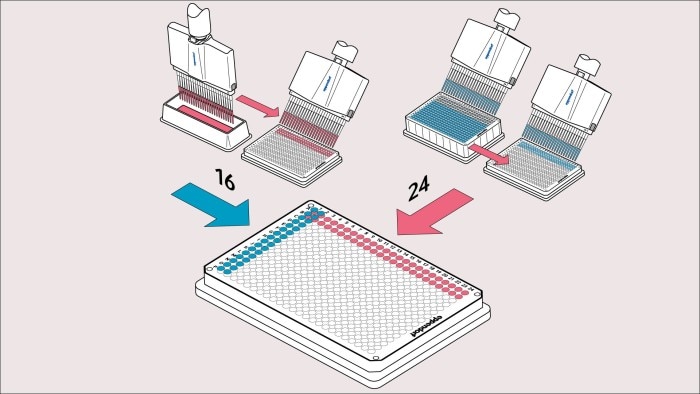
Tipp: With electronic pipettes, the multichannel pipetting of reaction liquids into 384-well plates can be even further accelerated . Using the dispensing mode not only relaxes your muscles and eyes but saves you up to 80 % of the time compared to 8/12-channel pipettes.
Adjustable tip spacing pipettes move multiple samples simultaneously from one vessel format to another. Instead of pipetting 384 times using a single-channel pipette, you can transfer up to 12 samples simultaneously into a 384-well plate.
So, put aside your single-channel pipette, move samples from 96-well plates with a 12-channel adjustable tip spacing pipette, and save up to 70% time! Likewise, for moving samples from tubes, you save up to 64% time by using an 8-channel adjustable tip spacing instead of a single-channel pipette.
- 2. Adjustable tip spacing pipettes for individual samples:
70 % time-saving
70 % time-saving
Adjustable tip spacing pipettes move multiple samples simultaneously from one vessel format to another. Instead of pipetting 384 times using a single-channel pipette, you can transfer up to 12 samples simultaneously into a 384-well plate.
So, put aside your single-channel pipette, move samples from 96-well plates with a 12-channel adjustable tip spacing pipette, and save up to 70% time! Likewise, for moving samples from tubes, you save up to 64% time by using an 8-channel adjustable tip spacing instead of a single-channel pipette.
Mehr erfahren
Weniger lesen
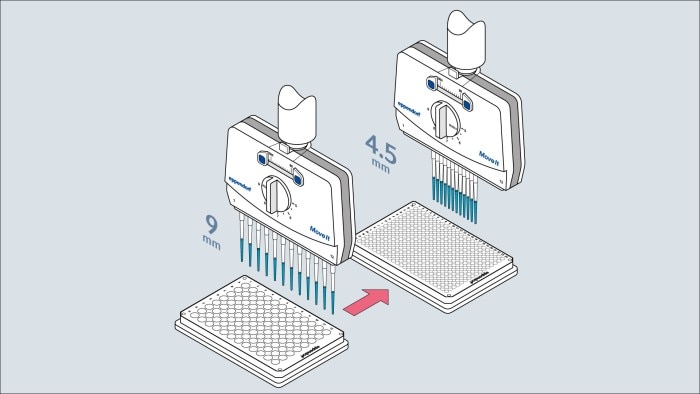
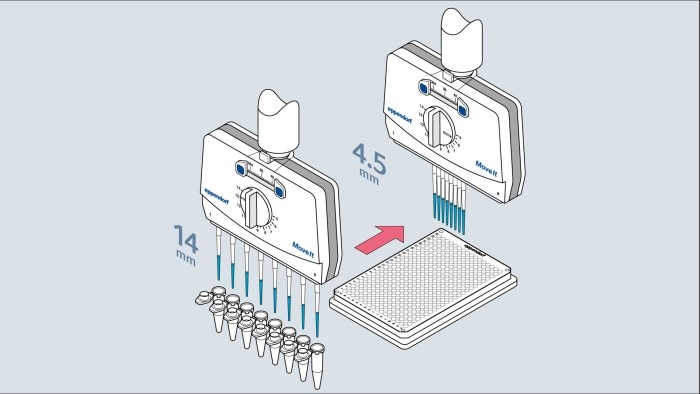
- 3. Combine both for maximum outcome
The most efficient way to manually fill a 384-well plate is the combination of both:
- 1. Loading reaction liquid: 24-channel electronic pipette
- 2. Individual sample transfer: Adjustable tip spacing pipette
Both combined save you up to 70% time.
Mehr erfahren
Weniger lesen
